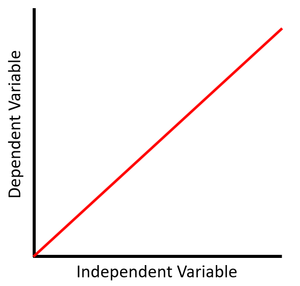Difference between pages "Effervescence" and "Directly Proportional"
(Difference between pages) (→About Direct Proportionality) |
|||
| Line 1: | Line 1: | ||
| − | ==Key Stage | + | ==Key Stage 4== |
===Meaning=== | ===Meaning=== | ||
| − | + | When two [[variable]]s are '''directly proportional''' when one [[variable]] is multiplied by a factor, the other [[variable]] is multiplied by the same factor. | |
| + | |||
| + | ===About Direct Proportionality=== | ||
| + | : A [[Scatter Graph|scatter graph]] showing a '''directly proportional''' relationship has a [[linear]] [[gradient]] that passes through zero, it has a [[y-intercept]] of zero. | ||
| + | : On a [[proportional]] [[Scatter Graph|scatter graph]] when one [[variable]] doubles, the other doubles or when one triples the other triples. | ||
| + | : When two variables are '''directly proportional''' when any value for y is divided by its corresponding value for x it will always give a constant value. | ||
| + | : Two variables are said to be '''directly proportional''' when they always vary by the same ratio. | ||
| + | |||
| + | ===Examples=== | ||
| + | {| class="wikitable" | ||
| + | |- | ||
| + | |[[File:DirectlyProportionalSketchGraph.png|center|300px]] | ||
| + | | style="height:20px; width:300px; text-align:center;" |This [[Scatter Graph|scatter graph]] shows a [[linear]] relationship that is [[Directly Proportional|directly proportional]] where x doubles, y doubles. | ||
| + | |||
| + | <math>y = mx</math> | ||
| + | |||
| + | Where m, the [[gradient]], is positive. | ||
| + | |} | ||
| + | |||
| + | ===References=== | ||
| + | ====AQA==== | ||
| + | |||
| + | :[https://www.amazon.co.uk/gp/product/019835939X/ref=as_li_tl?ie=UTF8&camp=1634&creative=6738&creativeASIN=019835939X&linkCode=as2&tag=nrjc-21&linkId=57e96876985fc39b1a3d8a3e3dc238b6 ''Directly proportional, pages 158-159, 282, GCSE Physics; Third Edition, Oxford University Press, AQA ''] | ||
====Edexcel==== | ====Edexcel==== | ||
| − | :[https://www.amazon.co.uk/gp/product/1292120193/ref=as_li_tl?ie=UTF8&camp=1634&creative=6738&creativeASIN=1292120193&linkCode=as2&tag=nrjc-21&linkId=572df39392fb4200db8391d98ae6314e '' | + | :[https://www.amazon.co.uk/gp/product/1292120193/ref=as_li_tl?ie=UTF8&camp=1634&creative=6738&creativeASIN=1292120193&linkCode=as2&tag=nrjc-21&linkId=572df39392fb4200db8391d98ae6314e ''Direct proportional, page 427, GCSE Combined Science, Pearson Edexcel ''] |
| − | |||
Revision as of 15:21, 5 December 2021
Contents
Key Stage 4
Meaning
When two variables are directly proportional when one variable is multiplied by a factor, the other variable is multiplied by the same factor.
About Direct Proportionality
- A scatter graph showing a directly proportional relationship has a linear gradient that passes through zero, it has a y-intercept of zero.
- On a proportional scatter graph when one variable doubles, the other doubles or when one triples the other triples.
- When two variables are directly proportional when any value for y is divided by its corresponding value for x it will always give a constant value.
- Two variables are said to be directly proportional when they always vary by the same ratio.
Examples
| This scatter graph shows a linear relationship that is directly proportional where x doubles, y doubles.
\(y = mx\) Where m, the gradient, is positive. |
References
AQA
- Directly proportional, pages 158-159, 282, GCSE Physics; Third Edition, Oxford University Press, AQA
